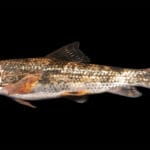This article explores the fascinating world of hemispheroid body shapes in fishes, delving into their evolutionary origins, ecological advantages, and the remarkable diversity they represent within the aquatic realm. While “hemispheroid” isn’t a formally defined ichthyological term, we’ll use it here to describe fish with moderately deep, rounded bodies, distinct from extremely flattened or elongated forms.
The Hemispheroid Advantage: Maneuvering in Complex Environments
Why are some fish shaped like little blimps? This hemispheroid body form, while less common than the sleek torpedo shape of open ocean swimmers or the flattened profile of bottom dwellers, offers a unique set of advantages. It’s all about maneuverability and stability, particularly in complex habitats like coral reefs or rocky shorelines. Imagine navigating a crowded city in a compact car—that’s the hemispheroid advantage. These fish can make tight turns, dart around obstacles, and precisely control their movements in close quarters, crucial for both predator avoidance and prey capture.
Living Between Two Worlds: Benthic vs. Pelagic Habitats
The benthic-pelagic axis, representing the gradient from the ocean floor to the open water, plays a significant role in fish body shape evolution. Benthic fishes, living near the substrate, often exhibit diverse body shapes, including both flattened and hemispheroid forms. This likely reflects the selective pressures of maneuvering near the bottom, requiring both stability and the ability to navigate complex terrain. Pelagic fishes, in contrast, typically have streamlined, fusiform bodies optimized for speed and efficiency in the open ocean. Hemispheroid shapes, occupying a middle ground, may represent a compromise between maneuverability and stability, particularly in structurally complex benthic habitats. (Source: Body shape diversification along the benthic–pelagic axis in marine fishes)
Reef Life: Thriving in a Three-Dimensional World
Coral reefs are bustling underwater cities, and hemispheroid fish have carved out specific niches within these complex ecosystems. While elongation is a dominant axis of body shape variation in reef fishes, hemispheroid forms offer an alternative strategy. They might specialize in picking off small invertebrates from crevices, navigating intricate coral branches, or occupying specific microhabitats where their body shape confers an advantage. (Source: A Morphospace for Reef Fishes: Elongation Is the Dominant Axis) This highlights the adaptive radiation of fish body shapes within reef environments, with hemispheroid forms representing a distinct and successful evolutionary pathway.
The Mysteries of the Deep: Untapped Potential
The deep sea, a vast and largely unexplored realm, remains a hotspot for fish body shape evolution. While our knowledge of hemispheroid fish in these depths is limited, the unique selective pressures of the deep sea—extreme pressure, limited food resources, and constant darkness—may have driven the evolution of unique hemispheroid adaptations. Further research is needed to uncover the secrets of these deep-sea dwellers and the potential advantages their body shape provides. (Source: The deep sea is a hot spot of fish body shape evolution)
Form and Function: A Story of Adaptation
The hemispheroid body shape isn’t just about looks; it’s intrinsically linked to function. Researchers are actively investigating how this shape influences a fish’s swimming performance, maneuverability, stability in currents, and its ability to avoid predators and capture prey. To model the unique protection mechanisms used by prehistoric fishes or even modern fish species, researchers have found out about the use of scales, skin, and even lamellar armor to protect the hemispheroid body of fish species. Studying the functional morphology of hemispheroid fish helps us understand the interplay between form and function in the evolutionary history of fishes.
Tracing the Family Tree: Evolutionary History and Phylogeny
Examining the phylogenetic structure of fish body shape provides insights into the evolutionary history of hemispheroid forms. Are these shapes clustered on certain branches of the fish family tree, suggesting a common ancestor? Or have they evolved independently multiple times in different lineages, a process known as convergent evolution? Studies on diverse inland fish faunas can offer a framework for understanding how phylogeny influences body shape evolution. (Source: Phylogenetic structure of body shape in a diverse inland ichthyofauna)
Size Matters: The Body Size Puzzle
Fish exhibit an astounding range in body size, from the tiny Philippine goby to the massive whale shark. The relationship between body size and shape, particularly for hemispheroid fish, is an active area of research. Do larger hemispheroid fish face different challenges than smaller ones? How does size influence their maneuverability and stability? Further research is needed to unravel the complex interplay between size, shape, and ecology in these fascinating creatures. (Source: Diversity and Evolution of Body Size in Fishes)
Unraveling the Diversity of Fish Species
The diversity of fish species is truly astonishing. With over 34,800 identified species—more than all other vertebrates combined—and approximately 250 new species discovered annually, the aquatic world teems with a breathtaking array of life. This diversity is reflected not only in the sheer number of species but also in their remarkable variations in body shape, size, fin morphology, and habitat preferences. From the flattened bodies of rays adapted for benthic life to the streamlined forms of pelagic tuna built for speed, fish have evolved a remarkable array of adaptations to thrive in virtually every aquatic environment on Earth.
How Fish are Classified
Understanding this vast diversity requires a system of classification. Fish are broadly categorized by jaw structure:
- Jawless fish (Agnatha): These ancient fish, like lampreys and hagfish, lack jaws and possess cartilaginous skeletons.
- Cartilaginous fish (Chondrichthyes): This group includes sharks, rays, and chimeras, characterized by skeletons made of cartilage rather than bone.
- Bony fish (Osteichthyes): The vast majority of fish species belong to this group, possessing bony skeletons and a wide variety of body shapes and fin structures.
Further classification relies on characteristics such as fin arrangement, coloration, and skeletal features. Scientists use meristics (counts of skeletal elements like fin rays and vertebrae) and morphometrics (measurements of body proportions) to distinguish between species and understand their evolutionary relationships. Ongoing research, particularly using genetic techniques, continues to refine our understanding of fish taxonomy and reveal hidden connections between species.
| Feature | Examples |
|---|---|
| Body Shape | Flat (rays), Elongated (eels), Streamlined (tuna), Hemispheroid (Pufferfish) |
| Fin Type | Cartilaginous (sharks), Bony (most fish) |
| Habitat | Freshwater, Saltwater, Brackish |
The Ongoing Quest for Knowledge
The study of hemispheroid fish, and fish diversity in general, is an ongoing journey of discovery. While we’ve learned much about the evolution, ecology, and functional morphology of these remarkable creatures, there’s still much to uncover. Ongoing research is constantly refining our understanding, and new discoveries await us in the depths of our oceans and the intricacies of aquatic ecosystems. This continuous quest for knowledge underscores the dynamic nature of science and the ever-evolving story of life on Earth.









